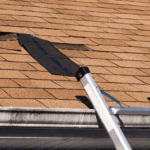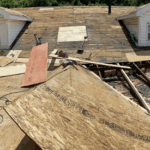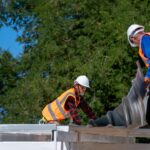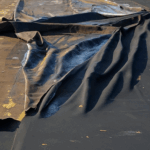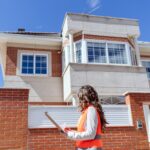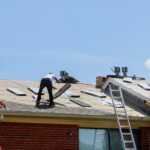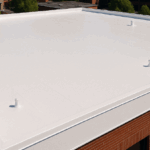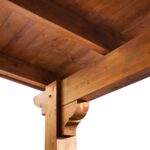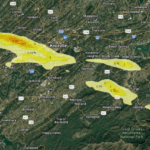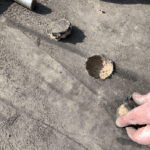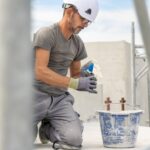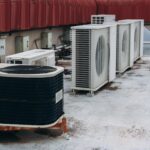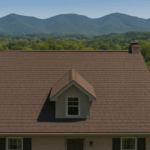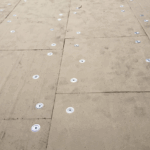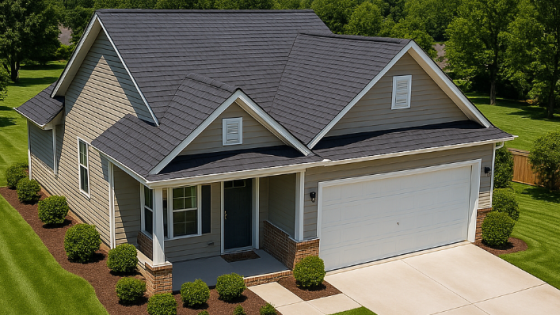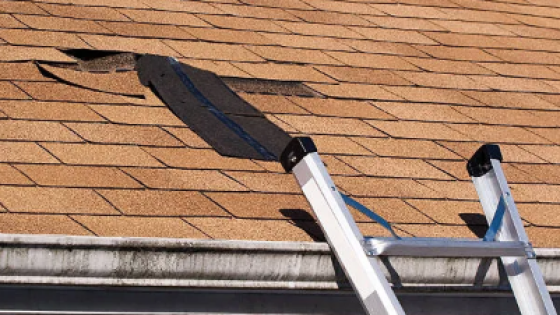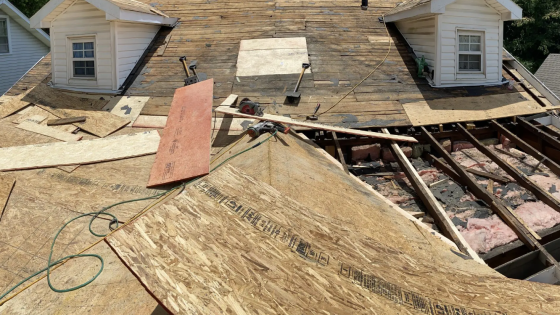Storms in East Tennessee can be as unpredictable as they are damaging. According to data from the National Oceanic and Atmospheric Administration (NOAA), Tennessee experiences hundreds of severe thunderstorm warnings each year, many of which bring hail, high winds, and torrential rain. These events pose a serious threat to your home’s roofing system.
As a Knoxville homeowner, one of the most vital skills you can learn is how to identify roof storm damage—from the ground. Knowing what to look for without climbing a ladder keeps you safe while still allowing you to take fast action. In this article, we will walk you through every step of the process, from spotting signs of damage to understanding your insurance rights, with a heavy focus on visual indicators from the ground.
Let’s dive into the signs, statistics, and steps every homeowner should know after a storm.
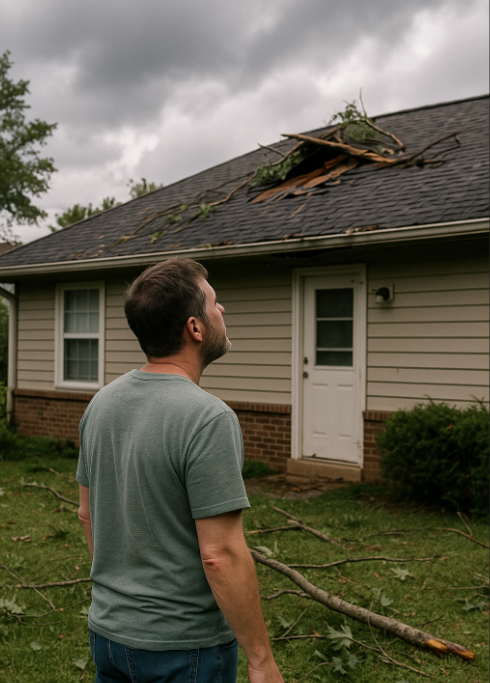
Key Takeaways
💡You Can Identify Roof Storm Damage Safely from the Ground.
💡Post-Storm Inspections Prevent Bigger Issues.
💡Professional Help Strengthens Insurance Claims.
💡Knoxville is Prone to Severe Weather.
Post-Storm Roof Inspections Matter
According to FEMA, roof systems are among the most vulnerable parts of a home during severe weather events. After a storm, roof damage can go unnoticed until leaks or mold appear weeks later.
- FEMA Fact: Wind speeds as low as 45 mph can start dislodging shingles and flashing.
- NOAA Records: Tennessee saw over 280 severe weather reports in 2023 alone, many involving high winds or hail.
Timely inspections after a storm can prevent:
- Water damage & mold
- Structural damage
- Insurance claim delays
- Increased repair costs
How to Identify Roof Storm Damage from the Ground
While hiring a Knoxville TN roofer is always recommended, here are specific signs you can spot from the safety of your yard or driveway.
1. Check for Missing or Displaced Shingles
Wind and hail are notorious for ripping or loosening asphalt shingles. Look for:
- Bare spots on your roof
- Shingles on your lawn or in gutters
- Uneven rooflines or exposed underlayment
🔍 Pro Tip from Litespeed Construction: Use binoculars for a closer look from the ground, especially if your roof has a steep slope.
2. Scan for Granule Loss
Shingles have a sandpaper-like coating (granules) that protects against UV rays and water. Hail and wind can strip this layer, leading to early shingle deterioration.
- Look for dark patches or inconsistent texture on the roof.
- Check your downspouts and gutters for granule accumulation.
🔍 Pro Tip from Litespeed Construction: Using polarized glasses can help you spot shiny areas on your roof which indicate areas of roofing shingles that have lost their granules.
3. Inspect Flashing and Roof Edges
Roof flashing, especially around chimneys, vents, and skylights, can get bent or dislodged during storms.
- From the ground, look for shiny metal pieces sticking out or dangling.
- Torn or rusted flashing may also be a sign of prolonged damage.
4. Check for Gutter and Fascia Damage
Strong wind can bend or detach gutters. Hail might dent them. Look for:
- Sagging or detached gutters
- Cracks, holes, or rusting
- Loose or missing fascia boards
5. Look for Signs of Water Leaks Inside
Sometimes, interior damage tells the story. After a storm:
- Check your attic for water stains, mold, or damp insulation.
- Look at ceilings for yellow or brown ring stains.
- Smell for musty odors in rooms near the roof.
Roof Damage Indicators
| Sign of Damage | Cause | Ground Visibility | Immediate Action Needed? |
|---|---|---|---|
| Missing Shingles | High Winds | Yes | Yes |
| Granule Accumulation in Gutters | Hail | Yes | Yes |
| Dented Gutters or Flashing | Hail/Wind | Yes | Yes |
| Sagging Gutters | Wind/Rain Weight | Yes | Yes |
| Water Stains on Ceiling | Leak Post-Storm | No (Interior) | Yes |
| Debris on Roof | Tree Limbs | Yes | Yes |
What Causes Roof Storm Damage in Knoxville, TN?
Knoxville’s location in the Tennessee Valley makes it vulnerable to all major storm types:
| Storm Type | Frequency (per year) | Common Damage |
|---|---|---|
| Thunderstorms | 50+ | Shingle loss, gutter damage |
| Hailstorms | 10–15 | Granule loss, cracked shingles |
| Tornadoes | 1–3 (localized) | Roof displacement, total destruction |
| Heavy Rain | 20+ | Leaks, wood rot, mold growth |
📚 Source: NOAA Storm Events Database
Insurance Claims: What You Should Know
If you’ve identified roof storm damage, your next move is contacting your insurance provider—but it helps to call a certified roofing professional first.
✅ What to Document:
- Photos from ground level (before and after storm if available)
- Shingles or debris in the yard
- Date and time of storm event
Local weather alerts (can be pulled from NOAA Storm Database)
Why Call a Roofer Before the Adjuster?
Insurance adjusters aren’t always trained roofers. Litespeed Construction’s certified inspectors can:
- Validate storm-related damage
- Meet with your adjuster on-site
- Help maximize your insurance claim
- Offer emergency tarping and repairs
Litespeed Construction’s Expert Roof Inspections
We don’t just serve Knoxville—we protect it. When storms hit, our crew responds FAST. Our certified inspectors know how to identify roof storm damage thoroughly, including:
- Drones for aerial inspections (when needed)
- Moisture detection tools
- Complete photo documentation for your insurance claim
- 24-hour emergency response services
FAQs: Identify Roof Storm Damage
Look for missing shingles, granule buildup in gutters, bent flashing, and gutter sagging. Use binoculars to inspect from a safe distance.
Yes, as long as you remain on the ground. Never climb onto a roof that may be compromised.
Call a roofer like Litespeed Construction first for documentation and inspection. This can make your insurance claim stronger.
Not all damage is visible from the ground. It's smart to have a professional inspection done anyway.
$300 to $1,000 for minor repairs. Full replacements due to storm damage can exceed $10,000 but may be covered by insurance.
Most standard policies cover wind and hail damage, but coverage varies by provider.
Immediately after the storm passes. Delaying can cause further water intrusion and weaken your claim.
Yes. Hail often causes granule loss or hidden cracks in shingles that compromise your roof’s integrity.
About 30–60 minutes for a standard home.
Call Litespeed Construction’s emergency line for same-day tarping and fast follow-up inspections.
Don’t Wait, Act Fast After a Storm
The sooner you identify roof storm damage, the better your chances of preventing costly repairs and filing a successful insurance claim. Trust Litespeed Construction—Knoxville’s top-rated roofing experts—to deliver fast, reliable, and honest service after any storm.
Call us today for a FREE inspection at (865) 297-3286.


